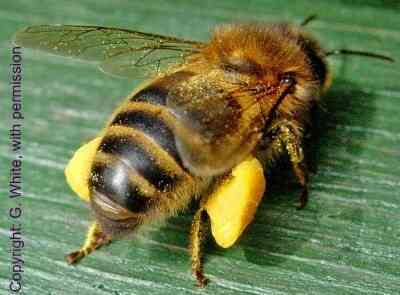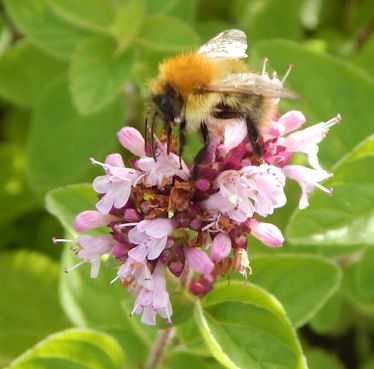How Many Legs Does A Bee Have?
Updated: November 2023
As humans, we mostly use our legs for getting about (walking, running, jogging, hopping) and we may use them for other things, such as lifting or pushing weights, or making ourselves smaller by bending.
However, bees have far more uses for their legs, all of which are vital for their survival.
Here, we'll take a look at how clever little bees make use of their six legs, and then we'll look at the structure of bee legs.
How many legs does a bee have and what do bees use their legs for?
Bees are insects, and like all insects, bees have six legs - or three pairs:
- two forelegs (to the front of the body)
- two middle legs
- two hind legs
Why do bees have six legs?

Bees need their legs to perform a variety of tasks, and some tasks are performed preferentially by one set of legs, whilst for some activities, all legs are equally important.
For instance, bees use their front legs for grooming their antennae, and they often use their front legs for grabbing.
It therefore makes sense for bees to carry most of the pollen on their hind legs, where it is out of the way, leaving the front legs unhampered to do their job.
Having a special function is possible because some legs have added features which assist the bee in different ways.
In this manner, the leg of a bee is adapted to perform many tasks, quite apart from the obvious of walking or scurrying about.
How do bees use their legs?
Here are some of the ways in which the legs of bees perform different tasks. Some of these tasks may surprise you!
1. Walking, 'running'
When they are not flying, bees use all of their legs for moving about on land or surfaces.
2. Gathering pollen
The hind legs on most female bee species are specially adapted to collect and transport pollen from the flower back to the nest or hive.
(However, cuckoo bee species do not gather pollen, rather they rely on pollen supplied by their target host).
Bees that gather pollen on their hind legs have special features or adaptations in the form of either:
- pollen baskets called corbicula (single) or corbiculae (plural). Pollen baskets are found on female social bees such as honey bees and bumble bees; or
- they have specially adapted, curled hairs called a floccus, which help to form a kind of pollen brush.
These are found on some female solitary bees, such as those belonging to the mining bee group.
Here is a honey bee worker with pollen baskets on the rear legs packed with pollen.

Here is an image of a painted mining bee. This bee collects the pollen in the floccus of each leg. Again, the rear legs are visibly full of pollen, which has a more powdery appearance in this case.

3. Tasting
Believe it or not, bees have taste buds on their front feet - this has certainly been proven to be the case with honey bees.
You can read more about this topic on the page how do bees taste.
4. Hearing
Scientists have proven that (certainly in the case of honey bees), sound vibrations are picked up by organs in the legs, called subgenual organs. Read more about this on my page Do Bees Have Ears.
5. Grooming - keeping clean
Grooming as a way of keeping clean, is very, very important for bees, and indeed other insects.
Bees are exposed to all kinds of micro-organisms and bacteria in the soil that could build up and hamper the bee, for example, either by causing infections or by clogging up the hairs that are so important for things like carrying pollen and keeping warm.
Bees even have special adaptations on their feet to help them keep spic and span. For example, the antennae of bees perform an extremely important function, and so to help keep them clean, bees have special 'antennae cleaners' located on the front legs.
However, cleanliness also requires that mites and other pests are dealt with and kept at bay.
6. Grabbing
There are times when bees need to grab things. For example, when flower anthers need to be grabbed and shaken to help release pollen.
Grabbing can also come in handy when defending the colony against pests.
Watch this video to see a honey bee use its legs to grab a Varroa mite before biting it:
7. Building
Bees use their legs to help them construct nest cells, whether this involves building them from wax as with honey bees and bumble bees, or applying a lining to the cell walls in a burrow.
For example, ground nesting bees often have a 'paint brush' (called a penicillus) on their hind legs (on the basitarsus) which they use to apply a lining to the cell walls of their burrows.

8. Gathering and Carding
Certain bee species use their legs to help them gather materials for nesting - notably carder bees of various types.
The wool carder bee is a prime example of this. It uses its legs and feet to help it gather hairs from plants such as lamb's ear, and transport them back to its nest where it will use the fine hairs to line and plug its nest cells, typically in hollow plant stems.
What are the parts of a bee leg called?
I first shared the image below on my page do bees have knees?
It comes from the book written by entomologist, Steven Falk, who wrote Field Guide to Bees Of Great Britain And Ireland. It clearly shows that a bee's leg is made up of segments.

The first segment of the leg is called the 'coxa'. This is the segment closest to the body. The second segment of the leg is a trochanter, and the third is the femur (which could be considered the bee's thigh).
The 'knee' is formed by the joining of the femur to the fourth leg segment called the tibia, and finally the basitarsus and tarsus (foot).
If a bee loses a leg, can it survive?
Having witnessed a common carder bumble bee flying about and active with one middle leg missing, I personally believe it is possible for a bee to survive if it loses a middle limb, at least for a little time, although it should be remembered that worker bees have short life spans in any case.
However, how long it would be able to survive is unclear. I suspect that if a bee loses a front leg or hind leg, it will be more severely hampered and may not survive for very long.
Do bees sleep?
Apparently they do, but how do we know?



